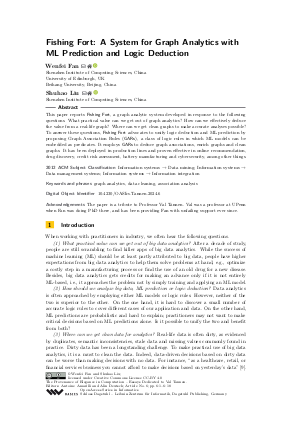OASIcs.Tannen.6.pdf
- Filesize: 2.47 MB
- 18 pages

 Creative Commons Attribution 4.0 International license
Creative Commons Attribution 4.0 International license

This paper reports Fishing Fort, a graph analytic system developed in response to the following questions. What practical value can we get out of graph analytics? How can we effectively deduce the value from a real-life graph? Where can we get clean graphs to make accurate analyses possible? To answer these questions, Fishing Fort advocates to unify logic deduction and ML prediction by proposing Graph Association Rules (GARs), a class of logic rules in which ML models can be embedded as predicates. It employs GARs to deduce graph associations, enrich graphs and clean graphs. It has been deployed in production lines and proven effective in online recommendation, drug discovery, credit risk assessment, battery manufacturing and cybersecurity, among other things.


















































Feedback for Dagstuhl Publishing